Abstract
In the present study, we identified changes in protein expression patterns of grapevine buds when treated with hydrogen cyanamide (HC). HC induced a shift of more than 2-folds in the expression of 1250 proteins out of approximately 7000 detected proteins. The majority of the differentially expressed proteins (DEPs) were localized in the chloroplast (419) and cytoplasm (347). Most of the detected DEPs were linked with energy metabolism, redox activity, hormone, and stress signaling. Particularly, the DEPs associated with defense and sugar metabolism showed significantly higher expression in HC-treated buds. Kyoto encyclopedia of genes and genomes (KEGG) analysis revealed significant enrichment for circadian rhythm, ribosome, and metabolic pathways. Moreover, the antioxidant activity of peroxidase (POD) increased at initial stages but declined at later stages (18 days post-treatment). This study identified several dormancy-related proteins that regulated signaling, as well as metabolic pathways upon HC application. The outcome of this study provides insights into the role of HC in dormancy release for grapevine production, hence useful to alleviate yield losses in mild winter regions.





Similar content being viewed by others
Abbreviations
- HC:
-
Hydrogen cyanamide
- TMT:
-
Tandem mass tag
- DEPs:
-
Differentially expressed proteins
- DPT:
-
Days post-treatment
- POD:
-
Peroxidase
- SOD:
-
Speroxidedismutase
- ABA:
-
Abscisic acid
- HPLC:
-
High-performance liquid chromatography
- FC:
-
Fold change
- EF:
-
Elongation factor
References
Ben Mohamed H, Vadel AM, Khemira H (2010) Estimation of chilling requirement and effect of hydrogen cyanamide on bud break and fruit characteristics of ‘Superior Seedless’ table grape cultivated in a mild winter climate. Pak J Bot 42:1761–1770
Ben Mohamed H, Vadel AM, Geuns JMC, Khemira H (2012) Effects of hydrogen cyanamide on antioxidant enzymes’ activity, proline and polyamine contents during bud dormancy release in Superior Seedless grapevine buds. Acta Physiol Plant 34:429–437. https://doi.org/10.1007/s11738-011-0839-0
Bi YD, Wei ZG, Shen Z, Lu TC, Cheng YX, Wang BC, Yang CP (2011) Comparative temporal analyses of the Pinus sylvestris L var mongolica litv apical bud proteome from dormancy to growth. Mol boil rep 38(2):721–729
Cai B, Wang H, Liu T, Zhuang W, Wang Z, Qu S, Qin Y (2019) Effects of gibberellins A 4 on budbreak, antioxidant enzymes’ activity and proline content of flower buds in sweet cherry (Prunus avium). Acta Physiol Plant 41(6):88
Chang E et al (2018) Proteome-Level analysis of metabolism-and stress-related proteins during seed dormancy and germination in Gnetum parvifolium. J Agri Food Chem 66(11):3019–3029
Chibani K, Ali-Rachedi S, Job C, Job D, Jullien M, Grappin P (2006) Proteomic analysis of seed dormancy in Arabidopsis. Plant Physiol 142:1493–1510
Druart N, Johansson A, Baba K, Schrader J, Sjödin A, Bhalerao RR et al (2007) Environmental and hormonal regulation of the activity–dormancy cycle in the cambial meristem involves stage specific modulation of transcriptional and metabolic networks. Plant J 50(4):557–573
Du W, Xiong CW, Ding J, Nybom H, Ruan CJ, Guo H (2019) Tandem mass tag based quantitative proteomics of developing sea buckthorn berries reveals candidate proteins related to lipid metabolism. J Proteome Res 18(5):1958–1969
Fadón E, Rodrigo J (2018) Unveiling winter dormancy through empirical experiments. Env Exp Bot 152:28–36
Halaly T, Pang X, Batikoff T, Crane O, Keren A, Venkateswari J et al (2008) Similar mechanisms might be triggered by alternative external stimuli that induce dormancy release in grape buds. Planta 228:79–88
Horvath DP, Anderson JV, Chao WS, Foley ME (2003) Knowing. When to grow: signals regulating bud dormancy. Trends Plant Sci 8:534–540
Karami O, Saidi A (2010) The molecular basis for stress-induced acquisition of somatic embryogenesis. Mol Biol Rep 37(5):2493–2507
Kermode AR (2005) Role of abscisic acid in seed dormancy. J Plant Growth Regul 24:319–344
Khalil-Ur-Rehman M, Sun L, Li CX, Faheem M, Wang W, Tao JM (2017a) Comparative RNA-seq based transcriptomic analysis of bud dormancy in grape. BMC Plant Biol 17:18
Khalil-Ur-Rehman M, Wang W, Xu YS, Haider MS, Li CX, Tao JM (2017b) Comparative study on reagents involved in grape bud break and their effects on different metabolites and related gene expression during winter. Front Plant Sci 8:1340
Khalil-Ur-Rehman M, Wang W, Dong Y, Faheem M, Xu Y, Gao Z, Tao J (2019) Comparative transcriptomic and proteomic analysis to deeply investigate the role of hydrogen cyanamide in grape bud dormancy. Int J Mol Sci 20(14):3528
Lang GA, Early JD, Martin GC, Darnell RL (1987) Endo-para and eco-dormancy: physiological terminology and classification for dormancy research. HortSci 22:371–377
Li M, Li D, Feng F, Zhang S, Ma F, Cheng L (2016) Proteomic analysis reveals dynamic regulation of fruit development and sugar and acid accumulation in apple. J Exp Bot 67:5145–5157
Mazzitelli L, Hancock RD, Haupt S et al (2007) Co-ordinated gene expression during phases of dormancy release in raspberry (Rubus idaeus L.) buds. J Exp Bot 58:1035–1045
Or E, Vilozny I, Eyal Y, Ogrodovitch A (2000) The transduction of the signal for grape bud dormancy breaking induced by hydrogen cyanamide may involve the SNF-like protein kinase GDBRPK. Plant Mol Biol 43:483–494
Or E, Vilozny I, Fennell A, Eyal Y, Ogrodovitch A (2002) Dormancy in grape buds: isolation and characterization of catalase cDNA and analysis of its expression following chemical induction of bud dormancy release. Plant Sci 162:121–130
Pawłowski TA (2007) Proteomics of European beech (Fagus sylvatica L.) seed dormancy breaking: influence of abscisic and gibberellic acids. Proteomics 7:2246–2257
Pérez FJ, Lira W (2005) Possible role of catalase in post-dormancy bud break in grapevines. J Plant Physiol 162:301–308. https://doi.org/10.1016/j.jplph.2004.07.011
Prassinos C, Rigas S, Kizis D, Vlahou A, Hatzopoulos P (2011) Subtle proteome differences identified between post-dormant vegetative and floral peach buds. J proteomics 74(5):607–619
Rohde A, Bhalerao RP (2007) Plant dormancy in the perennial context. Trends Plant Sci 12:217–223
Rohde A, Ruttink T, Hostyn V, Sterck L, Van Driessche K, Boerjan W (2007) Gene expression during the induction, maintenance, and release of dormancy in apical buds of poplar. J Exp Bot 58:4047–4060. https://doi.org/10.1093/jxb/erm261
Ueno S, Klopp C, Leplé JC, Derory J, Noirot C, Léger V, Le Provost G (2013) Transcriptional profiling of bud dormancy induction and release in oak by next-generation sequencing. BMC Genomics 14(1):1
Wang WB, Yunhee K, Haengsoon L, Kiyong K, Deng XP, Sangsoo K (2009) Analysis of antioxidant enzyme activity during germination of alfalfa under salt and drought stresses. Plant Physiol Biochem 47:570–577
Wu Y, Zhang W, Duan S, Song S, Xu W, Zhang C, Wang S (2018) In-depth aroma and sensory profiling of unfamiliar table-grape cultivars. Molecules 23(7):1703
Zhuang W, Gao Z, Wang L, Zhong W, Ni Z, Zhang Z (2013) Comparative proteomic and transcriptomic approaches to address the active role of GA4 in Japanese apricot flower bud dormancy release. J Exp Bot 64(16):4953–4966
Acknowledgements
The present research was supported by the National Key Research and Development Program of China (2018YFD0201300), China Agriculture Research System (CARS-29), Jiangsu Agricultural Industry Technology System (JATS [2019]417), Jiangsu Key Agricultural Project for New Cultivars Innovation (PZCZ201723), National Natural Science Foundation of China (Grant no. 31972384) and Jiangsu Agriculture Science and Technology Innovation Fund (CX(19) 2029.
Author information
Authors and Affiliations
Contributions
MKR and JMT designed the study. MKR performed the experiment and wrote the manuscript. WW and SI collected the samples. MKR, ZGS, and HZ analyzed the data. MF provided technical discussion and edited the manuscript draft. All authors approved the final version of manuscript.
Corresponding authors
Ethics declarations
Conflict of interest
The authors declare that they have no competing interests.
Electronic supplementary material
Below is the link to the electronic supplementary material.



Rights and permissions
About this article
Cite this article
Khalil-Ur-Rehman, M., Wang, W., Zheng, H. et al. Role of hydrogen cyanamide (HC) in grape bud dormancy release: proteomic approach. 3 Biotech 10, 229 (2020). https://doi.org/10.1007/s13205-020-02194-5
Received:
Accepted:
Published:
DOI: https://doi.org/10.1007/s13205-020-02194-5




